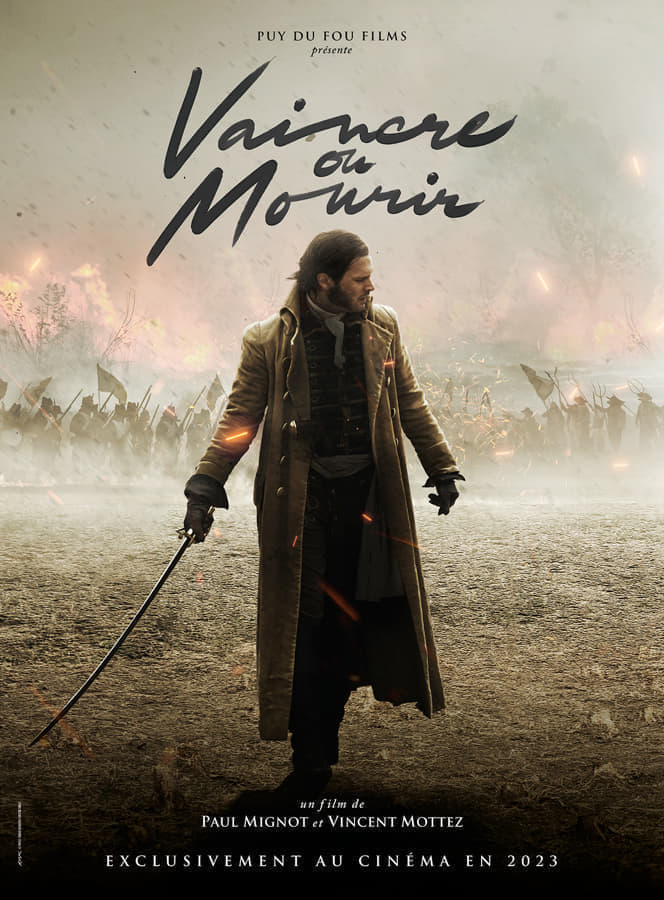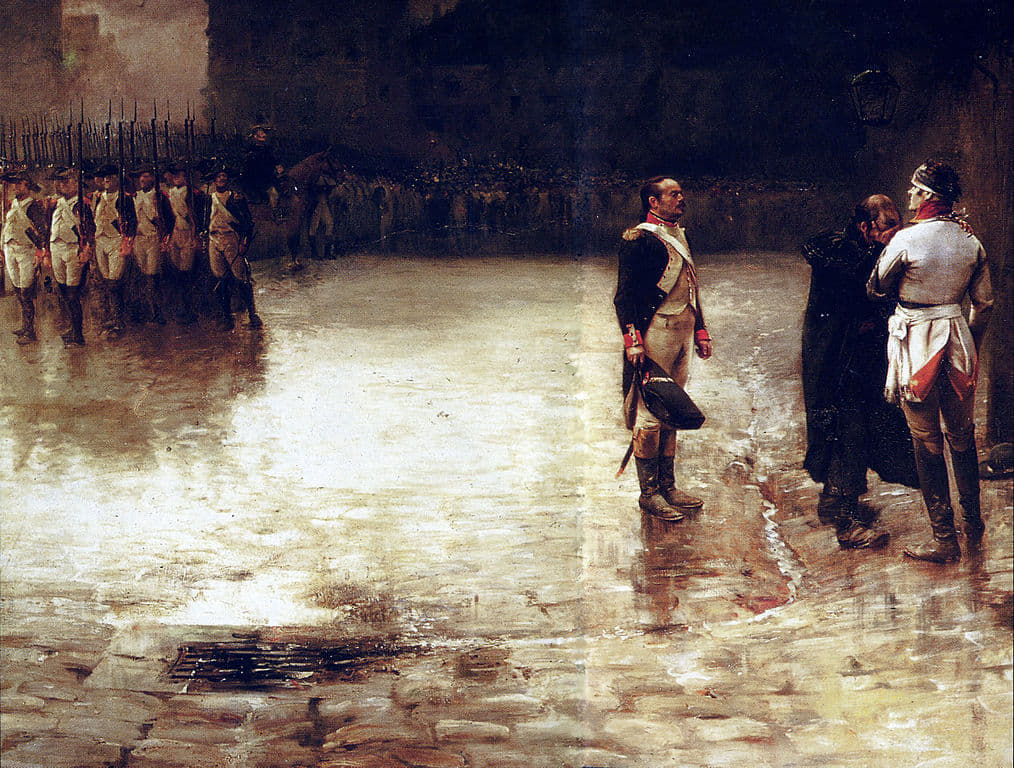At the beginning of this year, the first film production of Puy du Fou, Vaincre ou mourir (Win or Die), was released. And what have we heard from the critics? An extreme right-wing, fundamentalist, reactionary, anti-republican (horresco referens), hateful and ideological film. Musty France, the bottom of the rotten barrel. The relentless criticism of Libération further adds so much vitriol that it passes for being funny. These hack-writers carry out their vile orders, driven by a hatred of the Catholic religion, along with a progressive left-wing ideology of the narrowest kind. Their frivolous and superficial agitation seems to appear like a devil thrown into the font or a vampire shrinking from garlic. So, it’s a pleasure to see this film, for the entertainment, certainly, but also to give the middle finger to these paragons of good taste and opinion.
If this film disturbs the media and cultural fauna and flora, it is mainly because it contrasts radically with the current production. The long agony of a French cinema, a slot machine for the small screen, subsidized, petty bourgeois, for easy-consumption, never ceases to churn out painful films, using the same ideas and the same ideology. And sure enough—during the trailers, two films, before the screening, were like pulling teeth. The first one, Léo et moi (Leo and Me) by Victoria Bedos, tells how a teenager, in love with the new boy in her class, tries to approach him during a party by dressing up as a boy. Léo becomes friends with the transvestite and much more, as he falls in love with her. Questions of gender, choice of sexuality, confusion of feelings and identities are all part of the story. And then, Un Homme heureux (A Happy Man), where Luchini, learns that his wife, Catherine Frot, has just changed sex to become a man. And that’s it.
There’s also nothing much to say about Têtes givrées (Frost Heads), either, in which Clovis Cornillac plays a teacher who goes to save a glacier with his students, to fight against global warming—the Ministry of Ecological Transition validated this fi;m. Then, there’s the latest Asterix, entertainment for vegetative underdogs, gorged with filthy inculture and lukewarm Coca-Cola, coming in at a bloated budget of 65 million euros.

Between all this, there is Vaincre ou mourir (Win or Die). This film, without a big budget, without massive promotion, is good entertainment and nice propaganda. For a part of the film, however, something seemed to be wrong—there were no hysterical misandrist crazy women, no soy-boys in overalls, no one-legged black transsexuals, and no crazy non-binary interlopers. On the contrary, the women were as elegant and beautiful as they were virile and warlike; the brave and strong men of the Vendée had their orchids well-cultivated.
It is good to see a film about the period 1793-1796 from the other side. We have too often been formatted by the French Revolution of 1989 and fed with the great preconceived ideas about equality, liberty, the people, the poor against the rich, the evil, very evil nobility, the invincible Republic and the triumph of democracy over tyranny, all summed up in a kind of history for average Frenchmen in the Jack Lang sauce. The Villiers’ film has the merit of speaking to a wide audience about things so far removed from today’s France, so intimate to our society but so deep, however, in our common history—the king and the Catholic faith.
In this film, what do we see? Men who do not want to die out or surrender. They have an ideal: a Catholic and royal order. They will go to death, with bravery; they summon the great Roman virtues; they follow Christ; they go from feast to confession, from gallantry to artillery, sometimes with panache, sometimes with obstinacy. A phrase said by Charette is striking: “They are the new world but they are already old. We are the youth and the light of the world.” The glow in the lantern held by one of the king’s followers in the Vendée in the night, while they are being hunted, illustrates the hope of any struggle; the faith in the ideal, following the Lord who died for the truth. Throughout the film, we see white flags, priests and an ad orientem Mass, a close-up of a raised host. “For God and for the King” and other slogans that one could hardly hear except in meetings of the Action Française among young cubs full of testosterone, reach the viewer’s ears.
This well-paced film, which alternates between captivating battle scenes and informative scenes of hardly any length, pits the Whites against the Blues, the royalist Vendeans against the Republicans, in wars turned into butchery, where pitched battles give way to massacres and ravaged villages; where the art of war becomes a project of extermination of the Vendean race and has as its answer the defense of one’s land, the cult of the dead, the gift for one’s family, the loyalty to the King and the love of God, and oscillates between defeat and victory, hope and bitterness, the multitude of men and the solitude of the hero. A heroic breath breathes in the film. Charette, going to death and glory, becomes the romantic hero of lost causes and ruins. There are no concessions; peace is aborted because of the death of King Louis XVII, so one must either win or die. If one does not win, one dies. A beautiful radicality.
If Hugo Becker as Charette seemed, at the beginning, overcome by his role, undoubtedly himself frightened, he ends up before the firing squad as a martyr, rising to the heavens, alone and weary, piercing. Rod Paradot’s performance as a mad-dog resembles the boldness of the guys in my parish and complements Gilles Cohen’s performance as a quiet force. The actresses who play Céleste Bulkeley and Marie-Adélaïde de La Rochefoucauld are pearls among women. The dialogue sometimes lacks confidence; some lines are hollow, some ideas are avoided; the beginnings of the plot fall apart; but the whole, for lack of an extra sixty million euros, remains good, engaging, well directed.
As Alsatian as I am, far from Cholet and the two Sevres, the love of the Vendeans and the horror of the military expeditions of Kleber, a compatriot, touch me as if I were linked to these dead, French, massacred in hatred of religion and the old world replaced by a new one. The more we move away from the Revolution, the more we measure, in France, its terrible and deep effects; the violence of the ideas and the regime established, authoritarian under the guise of neutrality. This Vendéen heart, which has become a memory, summons a whole string of names, the illustrious viri of our France, and always reminds us, whether we are from the North, the South, or the East, of the blood of these Catholics who were led into genocide.
And the term, thrown like a ball and chain in the public debate, packed with all its explosive powder, does not detonate and divide as much the partisans, who see the mechanical will of the Republic to destroy the soul of the French and of France, with Reynald Secher or Le Roy Ladurie and Jean Tulard, as the more measured historians, like Jean-Clément Martin, cautious about the term “genocide” but sure of abominable massacres.
The film, although partisan, has many nuances. On the side of the Republicans, we find as many little gray and hateful men, little corporals, with the psychology of Manuel Valls, formed by a fascist and racist vision of the enemy, as those who, by opportunism or the march of history, took sides with the Republic for business or by chance. There were Kléber or Haxo, terrorists on legs, and Travot, seen as a just man, combining Catholicism and republic, assuming everything; and also Albert Ruelle, that kind of cynical deputy with the smile of a shrewd merchant. Among the Whites, the Count of Artois has it easy and confirms his mental obesity, his cowardice and his smugness. Against the intrepidity of Prudent Hervouët de La Robrie, there are the peace negotiations and the will to stop the fight by some, which stop the Vendeans from being made into total fanatics. The hero himself, Charette, brilliant, charismatic, brave and good, is caught in the trap of his radicalism, ending up isolated, answering an eye for an eye, worn out, on the verge of madness.
The film succeeds in being complex, and detaches itself from a thesis to be defended by posing a major problem: should the leader of men go all the way, even if it means running towards the massacre and his own defeat, in the name of an ideal, romantic in the end, despite the direction of history, and against political data? Or should he care, above all, about the common interest and his own, seek peace and compromise, if not survival, without ending up lukewarm, a centrist, or a coward in the eyes of history?
This is the difficulty of the one who sacrifices himself and puts his skin in the game, while others are complaining about their hemorrhoids in their country house in the Luberon, and in-between two appointments with the psychologist, as we all too often see, still, on screen, in the cinema.
Nicolas Kinosky is at the Centres des Analyses des Rhétoriques Religieuses de l’Antiquité and teaches Latin. This articles appears through the very kind courtesy La Nef.
Featured: Exécution du général Charette place de Viarmes à Nantes, mars 1796 (Execution of General Charette, Place de Viarmes, Nantes, March 1796), by Julien Le Blant; painted in 1883.
